This project is made possible through the partnership of Water Charity and the National Peace Corps Association. ![]()
Location
Bubazi & Gitwa Cells, Rubengera, Karongi, Rwanda
Community Description
The project community is the Bubazi Health Center Catchment Area. The Bubazi Health Center’s catchment area encompasses two cells, 15 villages, and has a 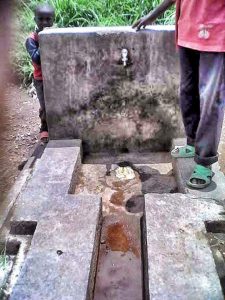 population of approximately 8,700 people. The two cells are: Bubazi Cell and Gitwa Cell. Bubazi Cell has a population of approximately 3,436 people and 7 villages. Bubazi Cell Villages: Kavumu, Kigarama, Gakomeye, Nyagahinga, Makurungwe, Gitwa, and Kabuga. Gitwa Cell has a population of approximately 5,271 people and 8 villages. Gitwa Cell Villages include: Rubona, Bizu, Muremerea, Kibande, Gaseke, Rwakigarati, Gitega and Rusegeya.
population of approximately 8,700 people. The two cells are: Bubazi Cell and Gitwa Cell. Bubazi Cell has a population of approximately 3,436 people and 7 villages. Bubazi Cell Villages: Kavumu, Kigarama, Gakomeye, Nyagahinga, Makurungwe, Gitwa, and Kabuga. Gitwa Cell has a population of approximately 5,271 people and 8 villages. Gitwa Cell Villages include: Rubona, Bizu, Muremerea, Kibande, Gaseke, Rwakigarati, Gitega and Rusegeya.
History of Area Water Sources
In the early 1970’s, a Swiss NGO (the name is unknown) established an Agricultural Project in the area of Bubazi Cell. They helped establish plantain farms and formal agriculture. To this day the people of the community are extremely knowledgeable about farming. Vegetables are abundant. Between 1972 -1976 the Swiss (that is how the locals refer to them) constructed the buildings of the compound that is now the Bubazi Community Health Center. In 1990 the Swiss built two extensive and efficient water distribution systems. Locally they are known as Gakoma Source and Gatunguguru Source. Both of these water sources seem to be prolific in their water supply. However, Gatunguguru Source appears to be especially vast.
The Gakoma Water Source distribution system originates from an underground source of water located at Gakoma Springs in a remote area of Gitega Cell. This distribution system, when in good working order, provides clean water, suitable for drinking, to four Cells (Gitega, Rohinga, Ruragwe and Bubazi) and thirteen villages.
The Gatunguguru Water Distribution System originates from an underground source of water located at Gatunguguru Springs in Muvungu Village, Gitega Cell. This distribution system, when in good working order, provides clean water, suitable for drinking, to four cells (Kayenzi, Ruragwe, Gitega and Bubazi) and eighteen villages.
The people of the Bubazi/Gitwa community are hard workers. They love to cultivate and dig. There is rain in the area nine months out of the year with a 3-month dry season. The climate is moderate and the terrain is lush. There is an abundance of underground, quality water at the Gakoma and Gatunguguru sources. The problem is access.
Problem Addressed
Both the Gakoma and the Gatunguguru water distribution systems were built in 1990. Sometime in the early 1990’s the Swiss NGO left Rwanda. Therefore, since the construction of these systems, 25 year ago, there has been very little maintenance of these systems. This system consists of large, main water lines coming directly from the sources, with feeder lines branching out from the main line. These feeder lines supply water tap systems where villagers can easily fetch clean water. Many of the feeder lines have broken and most of the taps systems have deteriorated and are unusable.
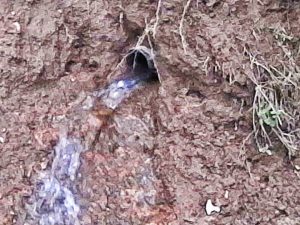 At one time these distribution systems provided water to 31 villages, possibly more. Most of these 31 villages no longer have access to these abundant water sources due to the deterioration of the distribution system. Just recently the main water line from Gakoma Source broke due to a mudslide. In Bubazi Cell there are only three villages that now receive water from these sources. Another problem is that these water distribution systems never reached Gitwa Cell, which, is one of the two cells in Bubazi Health Center’s catchment area. The citizens of Gitwa Cell (population 5,271) are still fetching their water from the Cyimbiri River.
At one time these distribution systems provided water to 31 villages, possibly more. Most of these 31 villages no longer have access to these abundant water sources due to the deterioration of the distribution system. Just recently the main water line from Gakoma Source broke due to a mudslide. In Bubazi Cell there are only three villages that now receive water from these sources. Another problem is that these water distribution systems never reached Gitwa Cell, which, is one of the two cells in Bubazi Health Center’s catchment area. The citizens of Gitwa Cell (population 5,271) are still fetching their water from the Cyimbiri River.
Project Description
The Bubazi Water Project is divided into 2 projects, Bubazi Water Project 1: Gakoma Source and Bubazi Water Project 2: Gatunguguru Source. This project will implement the larger of the two, Bubazi Water Project 1: Gakoma Source.
The work will be completed as follows:
1. The entire Gakoma Source main line will be repaired and protected.
2. All the water catchment tanks, and feeder lines to these tanks, that are supplied by the Gakoma Source will be repaired and put in good working order.
3. The water taps directly on the entire main line will be repaired and made operable.
4. All of the water taps (water fetching stations), and distribution lines supplying these taps in the 7 villages of Bubazi cell, that are fed by the Gakoma line, will be repaired, made in good working order, and made available for the all people of the community for water access.
5. All feeder lines to the Bubazi Health Center will be repaired and holding tanks on Health Center grounds will be repaired and made in good working order.
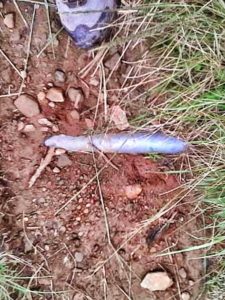
The Project 1: Gakoma Source should take approximately 8 weeks to complete, progressing as follows:
Week One: Site Installation – 5 days:
1. Engineer on site
2. Material storage and security arranged
3. Organization of the labor force
4. Materials ordered
Week One – Week Three – 12 days: Site Preparation
Week One – Week Three – 14 days: Supply, installation and laying of pipes and fittings from the tank to terminals fountain
Week One – Week Five – 30 days: Trench Excavation on the total length of GAKOMA Source system
Week Three – Week Five – 21 days: Backfilling and compacting for the entire length of 500 m x 0.5 x 0.6 m
Week One – Week Seven – 40 days: Rehabilitation of Tanks and Water Taps (15 single fountains (size 3 m x2 m, h=1.2 m, thickness = 0.20 m)
Week Six – Week Eight – 7 days: Site cleaning
Claude Kaliza, the Engineer, will be the project manager. He is reliable and efficient, and has already created an extensive report, at no cost, with pipeline maps, cost analysis, and a project timeline.
The community will be providing the labor for trench excavation of the total length of the Gakoma line, 500 m of excavation, and 40% of the backfilling and compacting of the entire length of 500 m.
Project Impact
This project will directly benefit 8,700 people.
Peace Corps Volunteer Directing Project
April Zachary
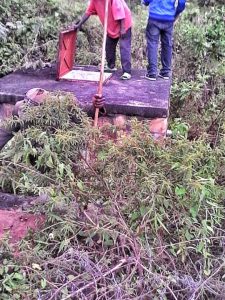 Monitoring and Maintenance
Monitoring and Maintenance
The Bubazi Health Center will be taking responsibility for the maintenance of the Gakoma Source Water Distribution System. The Bubazi Health Center’s maintenance plan for the Gakoma Source distribution system is as follows:
1. Each March, when the Health Center’s budget is planned, the health center will request funds for the year’s maintenance/repair of the water distribution system.
2. The health center will create a contract with a local plumber who will work for them on an on-call basis for any repairs or maintenance needed for the system.
3. The Executive Secretary of Bubazi Cell and the Bubazi Health Center Titulier will require each Village to create a Village Water Security Committee (VWSC). The committee will have a minimum of 3 people (more if possible) who will be responsible for the Water Security in their villages. They will provide quarterly Water Security Awareness Training to the people of their village. The training will have the purpose of inspiring the community to take ownership of the water distribution system and to participate in keeping it secure and strong. Parents will be asked to talk with their children about the importance of keeping their water system functioning efficiently (this will help prevent the occasional vandalism that happens to the water lines by the children). Parents and children will be asked to report to the Water Security Committee any broken pipes, non-functioning tap systems or anything that could be related to water security
4. The Water Security Committee will do a monthly inspection of all of the water catchment tanks and tap systems in their village areas. They will report any problems (or potential problems) to the health center.
5. Quarterly, the people will clean (de-weed, etc.) the exterior of all water catchment tanks and taps systems, and the grounds around them, in their village area. They will report to the VWSC anything that looks unusual or could become a problem to water security.
6. The plumber will do an annual inspection of all water catchment tanks and taps in the Bubazi Cell.
7. The Health Center Titulier will have an annual meeting with the Village Water Security Committees in order to discuss any potential problems to the water security, any improvements needed to the reporting systems and any changes that need to happen within the committee (member rotations, etc.)
Comments
Peace Corps Volunteer April Zachary reports: It is imperative that leadership be a driving force behind a project this extensive and complex. Anastase Ntezimana has been the Titulier of the Bubazi Health Center for 10 years. He is passionate about bringing about positive behavior change within the lives of the people on the village level. He has made great progress within his community in the area of nutrition and prenatal care. Waterborne illnesses and hygiene continue to be urgent problems within the community due to the lack of access to quality water. When Anastase was informed that in order for the water project to be a possibility he would be required to bring in a qualified engineer to do a study of the water distribution system he did not hesitate.
Within one week he had an engineer, Claude Kaliza, brought onto the site to make the initial assessment. A day later we had his assistant, Emile, a Water Distribution Technician, brought in. Together, the water technician, a local plumber, and I walked the entire Gakoma Source distribution system (a five-hour round trip hike) The water technician had a special water system GPS system that identifies underground water lines. Three days later the water technician returned and we, along with the plumber, walked the entire line of the Gatunguguru Source distribution system (a four-hour round trip hike). During these exploratory hikes, local people familiar with each area and the locations of the water catchment tanks met us to show the way. This required coordination of the people through phone tagging. We had support every step of the way.
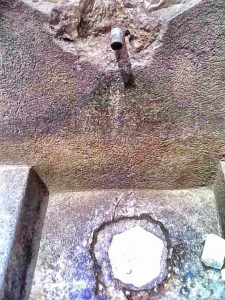 During the months of August and September 2015 a Community Needs Assessment (CNA) was done in the Bubazi Health Center catchment area (Bubazi and Gitwa Cells) through interviews, surveys, conversations and observation. Through the CNA inquiry of the people of Bubazi and Gitwa Cell, water quality/ access and hygiene were consistently found to be the most urgent problems in the Bubazi area. The majority of the Bubazi Health Center staff (10 out of 13) rated water quality/access and hygiene as the most urgent issues in their community. Home visits were made during the CNA and at the end of each interview, families were asked if there was anything they would like to add.
During the months of August and September 2015 a Community Needs Assessment (CNA) was done in the Bubazi Health Center catchment area (Bubazi and Gitwa Cells) through interviews, surveys, conversations and observation. Through the CNA inquiry of the people of Bubazi and Gitwa Cell, water quality/ access and hygiene were consistently found to be the most urgent problems in the Bubazi area. The majority of the Bubazi Health Center staff (10 out of 13) rated water quality/access and hygiene as the most urgent issues in their community. Home visits were made during the CNA and at the end of each interview, families were asked if there was anything they would like to add.
Here are some of their answers: “Water is a big problem. If you could try to help us get materials, the people could work together to bring water.” “We need help in teaching the people good hygiene. Are you able to help and support us in teaching the people good hygiene? The water is a problem.” The toilets are a big problem. If you could try, if there is a way that materials could be provided the people would build the toilets.”
During these visits it became very apparent that the people were willing to provide their labor in order to solve the problem of water quality/access and hygiene. They were offering their services before being asked. It was through these conversations with the people at the village level that we became conscious of this fact.
The holistic goal and desired outcome of the larger Bubazi Water Project (Project 1: Gakoma Source, Project 2: Gatunguguru Source and possibly Project 3: Gitwa Extension) is to provide the people of the Bubazi (and Gitwa) communities the means to create healthy, vital lives for themselves. In the Bubazi/Gitwa Communities, quality water is the foundation of good health, followed by education and behavior change. It is difficult to ask people to change behavior when they do not have the resources to do so – this is a set up for failure.
By making quality water accessible to the community we are setting the community up for success in the areas of good hygiene and good health. We will be following up this technical project with education projects:
1. Water Sanitation and Hygiene (W.A.S.H) program
2. Permagarden Training
3. Community Finance Initiative (CFI)
4. The First Thousand Days Program (working with the education of pregnant mothers and mothers in prenatal care and infant/child nutrition, the first thousand days of a child’s life).
Friends and family of Peace Corps Volunteer April Zachary may contribute using the donate button below. Funds in excess of the project amount will go to other projects in Rwanda.
![]() If you would like to help us with similar projects, please donate to the East Africa Water and Sanitation Program.
If you would like to help us with similar projects, please donate to the East Africa Water and Sanitation Program.
This project has been completed. To see the results, CLICK HERE.